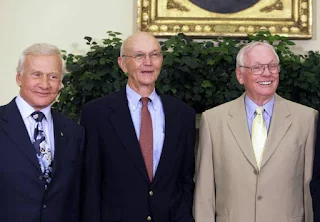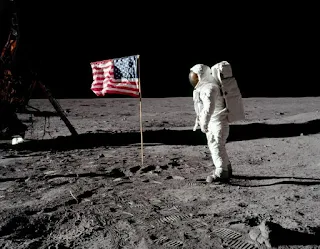As someone who was not born yet when the first humans successfully landed on the moon in 1969, I am curious about how the world reacted as the three NASA astronauts enter the lunar orbit.
For sure, it was surreal.
According to the NASA website, "an estimated 650 million people watched Neil Armstrong's televised image". And more millions listen to radio broadcasts across the globe.
Now, Apollo 11 mission will mark its 51st anniversary (July 2020) which made this article so relevant 😃And as with most commemorations of world-famous events, Apollo 11 memories were not without controversies to spill.
First the photos.
The man walking on the moon
Did you know that Neil Armstrong, the most popular among the three crew members of this mission, had only two photos taken on the moon?
Most of the still photos showing a man walking on the moon were not images of Neil Armstrong.
First the photos.
The man walking on the moon
Did you know that Neil Armstrong, the most popular among the three crew members of this mission, had only two photos taken on the moon?
Most of the still photos showing a man walking on the moon were not images of Neil Armstrong.
As the flight commander of the Apollo 11 mission, Armstrong took charge of the documentation on the moon, so, he held the camera during the duration of the moonwalk.
Buzz Aldrin walking on the moon and photographed by Neil Armstrong
(Armstrong can be seen in the visor of Aldrin)
This iconic shot (above photo) of a man walking alone on the moon's surface, had been deceiving people for decades.
Many thought the man was Neil Armstrong because he was the first person to step out on the lunar surface. But actually this was Buzz Aldrin, the Lunar module pilot (the vehicle that carried them to the moon) photographed by Neil Armstrong.
Many thought the man was Neil Armstrong because he was the first person to step out on the lunar surface. But actually this was Buzz Aldrin, the Lunar module pilot (the vehicle that carried them to the moon) photographed by Neil Armstrong.
Surprisingly, Neil Armstrong had only one or two still photos on the moon, photographed by Aldrin. And the image didn't capture him walking on the moon's surface but just a backshot of him climbing on the Lunar module. Why?
According to NASA records, as a mission commander, Neil Armstrong was responsible for the documentation and photographing of the moon's surface for experiments so he had to carry the 70mm camera all throughout the moonwalk. But he took plenty of shots of Buzz Aldrin.
Here's the only photo of Neil Armstrong on the moon photographed by Buzz Aldrin. showing Armstrong climbing to the Lunar Module, Eagle, after more than two hours of walking on the moon.
Neil Armstrong's climbing on the Lunar module
Neil Armstrong's climbing on the Lunar module
As the 51st anniversary of the first human landing on the moon draws nearer, it's surreal to look back at the most daring step taken by humans.
The Mission
According to the NASA website, the primary objective of Apollo 11 was to complete a national goal set by President John F. Kennedy on May 25, 1961: perform a crewed lunar landing and return to Earth safely.
Other objectives as stated on the NASA website: scientific exploration by the lunar module or LM crew, deployment of a television camera to transmit signals to Earth, and deployment of a solar wind composition experiment, seismic experiment package, and a Laser Ranging Retroreflector.
The historic Apollo 11 mission was the ninth endeavor in the 14-mission Apollo moonshot program of NASA (National Aeronautical and Space Administration) in an attempt to launch humans on the moon for the first time in human history.
Other objectives as stated on the NASA website: scientific exploration by the lunar module or LM crew, deployment of a television camera to transmit signals to Earth, and deployment of a solar wind composition experiment, seismic experiment package, and a Laser Ranging Retroreflector.
The historic Apollo 11 mission was the ninth endeavor in the 14-mission Apollo moonshot program of NASA (National Aeronautical and Space Administration) in an attempt to launch humans on the moon for the first time in human history.
Armstrong, Aldrin, and Collins on their way to the launch pad.
July 16, 1969. NASA images
July 16, 1969. NASA images
It was arguably the most dangerous mission yet ever undertaken by NASA and many have doubts if it would ever be fulfilled.
The mission preparation included the spacesuit rehearsals and study of the moon's surface through high-resolution photographs from the Surveyor and Lunar Orbiter programs.
They considered many craters, boulders, and cliffs where astronauts could land safely, given their fuel and time requirements.
They decided on the moon's Sea of Tranquility, a large basaltic region of the moon, as the lunar module landing site.
They considered many craters, boulders, and cliffs where astronauts could land safely, given their fuel and time requirements.
They decided on the moon's Sea of Tranquility, a large basaltic region of the moon, as the lunar module landing site.
The Apollo 11 Mission
It's a bit complicated to understand all these spacecraft terminologies: the modules, the rocket, and other complex technical terms.
Let's start with the rocket.
Let's start with the rocket.
Saturn V rocket that launched Apollo 11 to space
In order for the spacecraft to speed up to the orbit, it needed to be launched by a rocket, which is a heavy lift-launch vehicle capable of lifting more than 50 tons of payload into the low Earth orbit.
Because astronauts do not just board a helicopter or a commercial plane to reach space, they needed to be lifted up by a speeding rocket to shoot up high in space.
Because astronauts do not just board a helicopter or a commercial plane to reach space, they needed to be lifted up by a speeding rocket to shoot up high in space.
Saturn V rocket is considered the heaviest among the rockets of NASA and had three different stages with the Apollo program payload: the Command Module, the Service Module, and the Lunar Module.
The third stage will send the spacecraft to the moon, then will separate, and the astronauts will enter the command module to orbit the lunar space.
The third stage will send the spacecraft to the moon, then will separate, and the astronauts will enter the command module to orbit the lunar space.
During the Apollo 11 mission, as the Command Module (piloted by Michael Collins) approached the moon, Armstrong and Aldrin moved to the Lunar Module (piloted by Aldrin), the aircraft that landed them on the moon's surface. Collins remained in the Command Module orbiting the space.
So let's be clear here. Apollo 11 is not the name of the spacecraft that carried the three NASA astronauts to space and the moon, but the name of the spaceflight for this mission to the moon.
NASA used different terminologies and names for its programs, depending on what mission and exploration they undertook in space.
For the lunar exploration, they branded the program/project "Apollo" after the mythical Greek god of the moon.
Aldrin, Collins, Armstrong in July 1969
Aldrin, Collins, Armstrong in July 2009
NASA used different terminologies and names for its programs, depending on what mission and exploration they undertook in space.
For the lunar exploration, they branded the program/project "Apollo" after the mythical Greek god of the moon.
Michael Collins, the pilot of the Command Module, Columbia
For Apollo 11 mission, the spacecraft has three payload stages:
1. The Command Module named Columbia, piloted by Michael Collins. The one that took them to the lunar orbit (after it separated from the rocket) and back to earth.
2. The Service Module, supported the Command Module with necessary equipment like oxygen, electrical power, water etcetera.
3. The Lunar Module, Eagle, piloted by Buzz Aldrin. It has two stages, the descent stage for landing on the moon and the ascent stage that took them back to the orbit and reentered the Command Module with Michael Collins.
2. The Service Module, supported the Command Module with necessary equipment like oxygen, electrical power, water etcetera.
3. The Lunar Module, Eagle, piloted by Buzz Aldrin. It has two stages, the descent stage for landing on the moon and the ascent stage that took them back to the orbit and reentered the Command Module with Michael Collins.
Buzz Aldrin in front of the Lunar Module, Eagle.
Photographed by Neil Armstrong
This Lunar Module, Eagle, did not return to Earth. As soon as Aldrin and Armstrong re-entered the Command Module after the moonwalk, it was jettisoned or discarded (technically called the separation) and destroyed in space.
The Apollo 11 mission was launched on July 16, 1969, and entered the lunar orbit on July 20, 1969. Aldrin and Armstrong touched down on the moon on July 21, 1969.
Their re-entry to the earth's atmosphere was on July 24, 1969. The recovery site. or where they splashed down, was the Pacific Ocean.
The Astronauts
For Apollo 11 mission, NASA sent three of their most experienced astronauts, who had been into space prior to the Apollo 11 mission.. And astoundingly born in the same year, 1930!
From left: Neil Armstrong, Michael Collins, Buzz Aldrin
Neil Armstrong, the mission commander, a former US Navy fighter pilot and previously piloted Gemini 8 into space.
Colonel Edwin "Buzz" Aldrin, the pilot of the Lunar module, Eagle, that carried him and Armstrong to the lunar space. The first astronaut who had a doctorate degree to fly into space. He had previously piloted Gemini 12 into space and had performed a spacewalk during that mission. He was a US Air force fighter pilot and saw action in combat during the Korean war.
Lieutenant Colonel Michael Collins, the pilot of the Command module, Columbia. A test pilot in the US Air force, he piloted Gemini 10 into space in 1966 and also performed a spacewalk. He was a major general in the US Air force.
This mission to the moon was designed to be undertaken only by three astronauts. One pilot must stay with the Command Module orbiting the space. Two pilots will undertake the moonwalk and do the experiments and research on the moon's surface.
The Lunar Module could only accommodate two crew members, one pilot, and one flight commander. This was designed to be disintegrated into space once the astronauts will re-enter the Command Module.
This mission to the moon was designed to be undertaken only by three astronauts. One pilot must stay with the Command Module orbiting the space. Two pilots will undertake the moonwalk and do the experiments and research on the moon's surface.
The Lunar Module could only accommodate two crew members, one pilot, and one flight commander. This was designed to be disintegrated into space once the astronauts will re-enter the Command Module.
Collins, Armstrong, Aldrin
The Moon Landing
On July 20, 1969, as they drew closer to the moon, Neil Armstrong and Buzz Aldrin entered the Lunar Module, Eagle, and separated from the Command Module, Columbia.
As Armstrong and Aldrin headed toward the lunar surface onboard Eagle, Michael Collins piloted the Columbia and orbited the lunar space while waiting for his comrades to rejoin him.
As Armstrong and Aldrin headed toward the lunar surface onboard Eagle, Michael Collins piloted the Columbia and orbited the lunar space while waiting for his comrades to rejoin him.
Armstrong was the first to descend to the moon's surface followed by Aldrin 20 minutes later. Armstrong then notified the command center in Houston, Texas with the historic phrase: "Houston, Tranquility Base here. The Eagle has landed".
Buzz Aldrin performed a salute on the US Flag on the moon's surface
A video camera was installed in a panel inside the Eagle to send a transmission back to Earth with live coverage.
Armstrong uttered this iconic quote. "That's one small step for (a) man, one giant leap for mankind".
Armstrong uttered this iconic quote. "That's one small step for (a) man, one giant leap for mankind".
While on the moon's surface, Armstrong and Aldrin conducted several experiments, collected samples of lunar soil and rock to bring home, erected a US flag, and took core samples from the crust.
They also laid medallions with the names of several astronauts and cosmonauts who were killed in the flight and training (most prominently the three NASA astronauts killed during the test flight of Apollo 1).
They also left a 1.5-inch silicon disk with goodwill messages from 73 countries and the names of congressional and NASA leaders.
They also left a 1.5-inch silicon disk with goodwill messages from 73 countries and the names of congressional and NASA leaders.
Armstrong and Aldrin spent almost three hours on the moon's surface collecting samples for experiments. then boarded back to the Lunar Module to rejoin Michael Collins in the Command Module, Columbia.
Re-entry to the Earth Atmosphere
As soon as they re-entered Columbia, the Lunar Module, Eagle. was then separated and destroyed in space.
They headed back to Earth on board the Columbia after eight days in the lunar orbit. They splashed down in the Pacific Ocean at 12:50 in the afternoon, July 24, 1969, and were put on USS Hornet, the recovery ship.
They were put in a mobile quarantine facility before being taken to Houston where they remained in quarantine until August 10. Quarantining astronauts after a lunar space mission was part of the protocol in NASA to avoid spreading unwanted diseases (in case they had brought germs from outer space).
Neil Armstrong spent his 39th birthday in the quarantine facility.
Neil Armstrong spent his 39th birthday in the quarantine facility.
Controversy on who would descend first
Apollo 11 mission's success was not without controversies.
For weeks before the spaceflight schedule, there were debates, about who among the two astronauts would descend first on the moon's surface. As it was a historic moment, NASA officials were carefully weighing their decision.
Who would step out first?
Traditionally, spacewalks allow junior crew members to step out into the space first, leaving the flight commander at the controls in case of emergency. This tradition would have been allowed Aldrin to descend first instead of Armstrong.
But NASA leaders changed this setup because they wanted the flight commander to set a foot first on the moon for a symbolic purpose. So they had to redesign the flight command so that Armstrong would be the first to descend and not Aldrin.
Here are other Surprising Facts about the Apollo 11 mission:
1. The first meal of Aldrin and Armstrong on the moon was bacon, and the beverage was coffee. They were also the first to have hot water in space and the first to eat their food with a spoon instead of just squeezing it out of the bag.
2. They had no bathroom, so they used plastic bags and roll-on cuffs to pee and poop. During the duration of the spaceflight. The harder thing to do in space for the astronauts is to pee and poop, so they often used improvised materials to solve these problems.
3. Armstrong and Aldrin wore diapers while walking on the moon. Aldrin admitted in the interview that he urinated on his pants (of course with a diaper on) during the moonwalk. "It's lonely as hell out there", he said, "I peed in my pants".
4. A risky descent. As they approached the moon's surface, the lunar module, Eagle, had overshot its intended landing point which turned out to be covered with boulders, but could not be viewed by Aldrin, who piloted the Eagle, from his window. Neil Armstrong had to switch to a manual module and flew to an impromptu landing site.
5. An error code and alarm blares. The computer system of Eagle showed an error code with alarms blaring, but Armstrong ignored it and prepared for their landing at the moon's Sea of Tranquility.
6. The possibility of being stranded in space. Spaceflight experts are aware that no rescue team could be dispatched to the stranded astronauts in space if something will go wrong with the spacecraft. In the case of Apollo 11, Armstrong and Aldrin were aware that if their lunar module Eagle would malfunction, they would have to be abandoned on the moon (as the Command Module, Columbia, piloted by Collins, was not designed to fetch stranded astronauts in space and not capable of making a descent to take them).
7. Speech of death. In fact this possibility was imminent that President Richard Nixon at that time already prepared a speech of death in case they will die during the mission.
8. Lunar Module Eagle almost killed them. The discarded lunar module went berserk while it was disintegrating in space, chasing down the command module while they re-entered the earth's atmosphere. It almost crashed them.
9. Buzz Aldrin planted a Swiss flag on the moon first before he erected the US Flag. Why? Don't panic, it was deliberate. According to ESA (European Space Agency), one of the experiments involved during the Apollo 11 mission was to deploy a Swiss-made solar sail to study the composition of the solar winds washing over the Moon.
9. Buzz Aldrin planted a Swiss flag on the moon first before he erected the US Flag. Why? Don't panic, it was deliberate. According to ESA (European Space Agency), one of the experiments involved during the Apollo 11 mission was to deploy a Swiss-made solar sail to study the composition of the solar winds washing over the Moon.
Officially dubbed the Solar Wind Composition Experiment, the solar sail was also known as the "Swiss flag" experiment. Read related article, click HERE
Buzz Aldrin erected a "Swiss flag" on the moon's surface
Sadly, the mission commander, Neil Armstrong, was the only one among the three astronauts of Apollo 11 who did not make it to the 50th anniversary of the moon landing in 2019.
Armstrong died in 2012 following a routine heart surgery that went wrong at a Cincinnati hospital in the United States. He was 82.
Armstrong died in 2012 following a routine heart surgery that went wrong at a Cincinnati hospital in the United States. He was 82.
Neil Armstrong died in 2012
His death was regarded as medical malpractice. The Cincinnati Hospital paid his family $6 million as a damages settlement.
In what could have been a routine heart surgery, things got out of hand and went wrong when nurses removed wires linked to a temporary pacemaker.
As a result, Armstrong bled profusely into the membrane surrounding the heart. When he was brought to the operating room, his heart had stopped and he had brain damage.
He went into a coma and didn't regain his consciousness until he died a week later. He was cremated and his ashes were scattered in the ocean.
According to some sources and those who knew him, Armstrong treasured his privacy and didn't like the attention he got after the moon landing event. He preferred a quiet life.
According to some sources and those who knew him, Armstrong treasured his privacy and didn't like the attention he got after the moon landing event. He preferred a quiet life.
Buzz Aldrin is still visible in the media today
Unlike Armstrong, Buzz Aldrin fully embraced the stardom and enjoyed the popularity of being the second person in human history to walk on the moon.
He is still visible today giving lectures and interviews about space flights and the moon landing. He is strongly advocating the Mission to Mars.
After leaving NASA, he continued to advocate space exploration and has written many articles about his spaceflight experiences.
He is still visible today giving lectures and interviews about space flights and the moon landing. He is strongly advocating the Mission to Mars.
After leaving NASA, he continued to advocate space exploration and has written many articles about his spaceflight experiences.
The character of Buzz Lightyear in the Toy Story was named after him. He is currently active on social media.
Michael Collins
After leaving NASA, Michael Collins served the administration of President Nixon as Assistant Secretary of Public Affairs. In 1985, he started his consultancy firm, the Michael Collins Associates.
Updated: June 2022
You can follow Buzz Aldrin on Facebook. He is still active on the social media advocating space exploration.
A big salute to these three modern heroes who made a difference in the history of mankind! ✌👏💕





























0 Comments